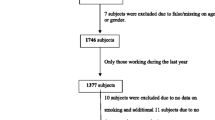Summary
In order to study the role of occupational exposure in the etiology of asthma, 78 asthmatics and 56 nonasthmatics from the Finnish twin cohort were investigated by means of a postal questionnaire. Among those studied were 31 identical twin pairs discordant with regard to asthma (i.e., only one member of the pair had asthma). The questionnaire inquired into the diagnosis and status of the asthma, smoking habits, atopic background, smoking history of the parents, and history as regards pets, and requested a detailed description of occupational exposure to airway allergens and irritants. Classification into asthmatics and nonasthmatics was based on the information gathered with the questionnaire, supplemented by other information whenever possible. Estimation of exposure was based on the subject's own report, on the work descriptions, and on the general knowledge about the exposure levels associated with work tasks in question. Exposure to organic solvents was found only in the asthmatic members of the discordant pairs, and none of the nonasthmatic persons had been exposed to solvents. There were no statistically significant differences as regards exposure to other unspecific irritants. Combined exposure to organic allergens and airway irritants was more common in the asthmatics than in the nonasthmatics (P = 0.009). Exposure to irritants was also more common among the asthmatics than the nonasthmatics with similar exposure to organic allergens (P = 0.004).
Similar content being viewed by others
References
Biagini RE, Moorman WJ, Lewis TR, Bernstein IL (1986) Ozone enhancement of platinum asthma in a primate model. Am Rev Respir Dis 134:719–725
Burge S (1982) Non-specific bronchial hyper-reactivity in workers exposed to toluene di-isocyanate, diphenyl methane di-isocyanate and colophony. Eur J Respir Dis 63:91–96
Durham SR, Graneek BJ, Hawkins R, Newman-Taylor AJ (1987) The temporal relationship between increase in airway hyperresponsiveness to histamine and late asthmatic response induced by occupational agents. J Allergy Clin Immunol 7:398–406
Edfors-Lubs M-L (1971) Allergy in 7000 twin pairs. Acta Allergol 26:249–285
Gerrard JW, Cockroft DW, Mink JT, Cotton DJ, Poonawala R, Dosman JA (1980) Increased nonspecific bronchial reactivity in cigarette smokers with normal lung function. Am Rev Respir Dis 122:577–581
Golden JA, Nadel JA, Boushey HA (1978) Bronchial hyperirritability in healthy subjects after exposure to ozone. Am Rev Respir Dis 118:287–294
Härkönen H, Nordman H, Korhonen O, Winblad I (1983) Long-term effects of exposure to sulfur dioxide. Am Rev Respir Dis 128:890–893
Kaprio J, Sarna S, Koskenvuo M, Rantasalo I (1978) The Finnish twin registry: formation and compilation, questionaire study, zygosity determination procedures and research program. Prog Clin Biol Res 2413:179–184
Keskinen H, Kalliomäki PL, Alanko K (1980) Occupational asthma due to stainless steel welding fumes. Clin Allergy 10:151–159
Keskinen H, Tupasela O, Tiikkainen U, Nordman H (1988) Experiences of specific IgE in asthma due to diisocyanates. Clin Allergy 18:597–604
Muranaka M, Suzuki S, Koizumi K, Takafuji S, Miyamoto T, Ikemori R, Tokiwa H (1986) Adjuvant activity of dieselexhaust particulates for the production of IgE antibody in mice. J Allergy Clin Immunol 77:616–623
Nielsen J, Welinder H, Schütz A, Skerfving S (1988) Specific antibodies against phthalic acid anhydride in occupationally exposed subjects. J Allergy Clin Immunol 82:126–133
Nieminen M, Kaprio J, Koskenvuo M (1971) A populationbased study of bronchial asthma in adult twin pairs. Chest 100:70–75
Nordman H, Keskinen H, Tiikkainen U, Tupasela O, Ahlberg RW (1987) Experience of specific antibodies in the diagnostics of phthalic anhydride allergy. 22nd International Congress on occupational Health, Sydney, Australia, Sept. 27-Oct. 2:89
Riedel F (1989) Tierexperimentelle Untersuchungen über den Zusammenhang zwischen Reizgasschädigung und bronchialer Sensibilisierung. Allergologie 12:112–113]
Riedel F, Krämer M, Scheibenbogen C, Rieger CHL (1988) Effects of SO2 exposure on allergic sensitization in the guinea pig. J Allergy Clin Immunol 82:527–534
Sarna S, Kaprio J, Sistonen P, Koskenvuo M (1978) Diagnosis of twin zygosity by mailed questionnaire. Hum Hered 28:241–254
Simmonsson BG (1982) Bronchial reactivity in relation to occupational bronchitis and asthma. Eur J Respir Dis 63 [Suppl 123]:27–33
Takafuji S, Suzuku S, Koizumi K, Tadokoro K, Ohashi H, Muranaka M, Miyamoto T (1989) Enhancing effect of suspended particulate matter on the IgE antibody production in mice. Int Arch Allergy Appl Immunol 90:1–7
Vesterinen E, Kaprio J, Koskenvuo M (1988) Prospective study of asthma in relation to smoking habits among 14729 adults. Thorax 43:534–539
Zetterstrbm O (1988) The increased prevalence of allergic airway disease. Allergy 43 [Suppl 8]:10–11
Author information
Authors and Affiliations
Rights and permissions
About this article
Cite this article
Antti-Poika, M., Nordman, H., Koskenvuo, M. et al. Role of occupational exposure to airway irritants in the development of asthma. Int. Arch Occup Environ Heath 64, 195–200 (1992). https://doi.org/10.1007/BF00380909
Received:
Accepted:
Issue Date:
DOI: https://doi.org/10.1007/BF00380909




